Contrary to what many people think, not all ants are wingless. The truth is, some of them have wings and can fly around your house.
Even carpenter ant species have their adult versions that can fly, and are simply called winged carpenter ants. Interestingly, their behavior is different from those without wings.
Winged carpenter ants look like flying termites, and people are usually mistaken in identifying one from the other. But upon looking closer at them side by side, one can easily spot the difference between them. These flying ants are the reproductive versions of carpenter ants.
Also known as alates or swarmers, flying carpenter ants are simply ants that have wings. As we all know, ants are very sociable insects, and they form a colony with a queen and thousands of workers.
This article will teach you everything about the queen ant, winged carpenter ants, and how to deal with an ant colony.
Identifying a Flying Carpenter Ant
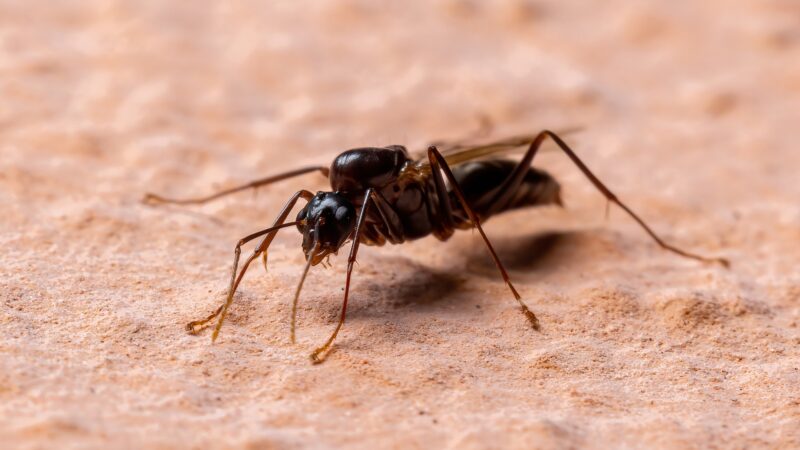
Winged carpenter ants have dark brown or black bodies and have two pairs of wings. Although flying termites also have four wings, the front wings of flying ants are larger than the hind wings. Male winged carpenter ants have larger wings than females. Both sexes have narrow waists and elbowed antennae.
Unlike winged termites, winged carpenter ants have a more pointed thorax. They also possess large heads with powerful jaws.
Male swarmers are about 18 mm long, while females can grow up to 20 mm long. They are the kings and queens of a carpenter ants colony and are a bit larger than wingless worker carpenter ants.
Do All Carpenter Ants Have Wings?
Not all carpenter ants have wings. Only the reproductive males and queens have wings, while the workers remain wingless in their lifetime. Winged carpenter ants are responsible for starting a new colony, while workers are responsible for foraging for food and protecting their colony, which takes years to become stable.
Why Do Some Carpenter Ants Fly?
Some carpenter ants fly so they can find a mate and reproduce. Male winged carpenter ants usually die shortly after mating, while the queen drops their wings on the ground and searches for a suitable nesting site. She will then lay about 20 eggs, which when hatched will grow into adults and are the first batch of workers.
Are Winged Carpenter Ants Bad?
Winged carpenter ants are not inherently bad. They don’t bite or sting humans and pets and don’t transmit diseases. These swarmers also don’t cause damage to structures and belongings. In fact, queens are great mothers and feed the larvae with fats and protein from their wing muscles until their pupal stage.
The Problem with Flying Carpenter Ants
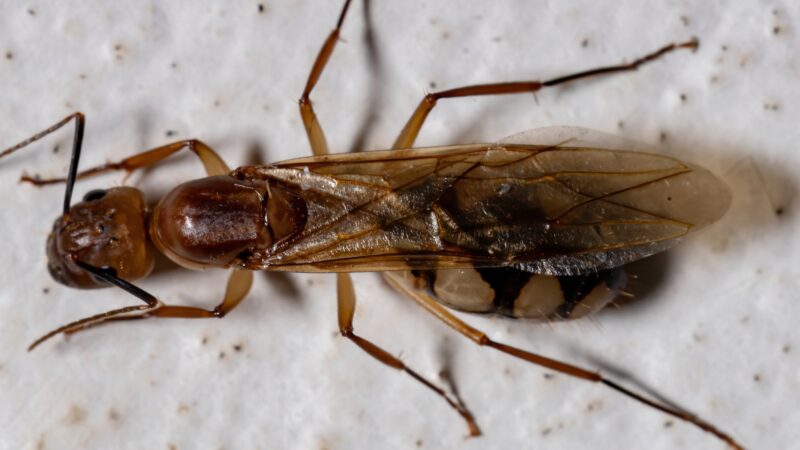
As mentioned above, flying carpenter ants are not dangerous and destructive. But then they reproduce and start a colony.
Once a colony is fully established, the workers can become pests. Although they don’t eat wood like termites, these wingless carpenter ants feed on meat, pet food, sugar, and other sweet foods.
What Attracts Flying Ants in Your House?
There are several things that attract flying ants to enter your house. Like most flying insects, winged ants are very attracted to lights. If you leave your windows open or their screens are damaged, and your lights are on at night, these queens and reproductive male ants will enter your home to mate and reproduce.
Flying carpenter ants thrive in wet areas and are also attracted to moisture. No wonder you may also find them in bathrooms, kitchens, refrigerator dip pans, and near water leaks.
They are also attracted to warmer temperatures or indoors a few days after rain. This is also why you are likely to see them during spring.
Why Are Winged Carpenter Ants in My House?
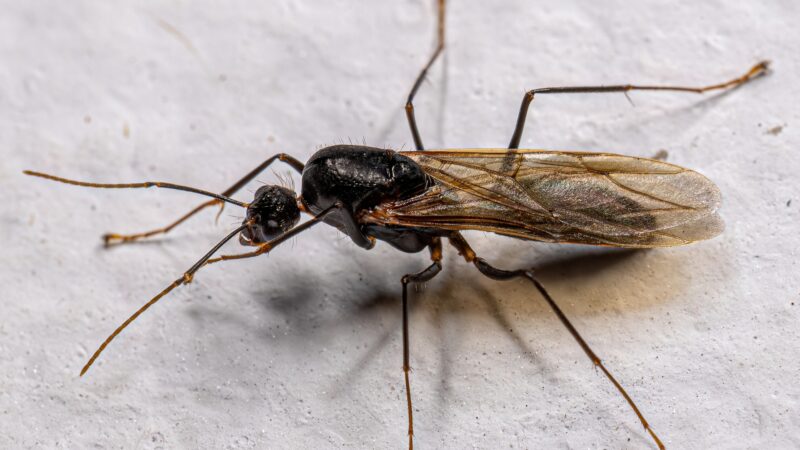
Aside from the attractants, winged carpenter ants are inside your house to find a mate. After they mate, the winged queen will find a comfortable place where she can lay eggs and start a new colony.
More importantly, these winged ants were able to find an entry point to get inside. Otherwise, they will find another place.
Can Flying Ants Damage Your Home?
Flying ants cannot damage your home since their only purpose is to mate and start a colony. However, their presence could be a sign of an ant infestation.
Flying and non-flying carpenter ants don’t eat wood. However, carpenter ants workers damage wooden structures by creating tunnels and galleries for nesting.
Should I Be Worried if I See One Winged Carpenter Ant?
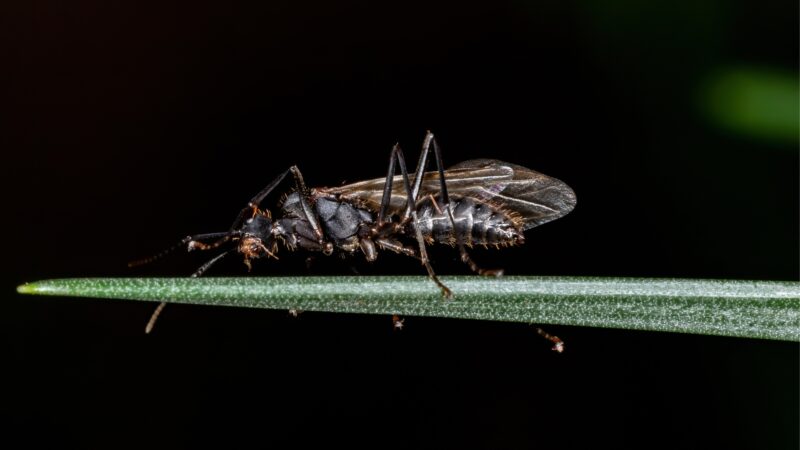
You should be worried even if you see one winged carpenter ant only. Note that it usually takes 3.5 to 4 years before a carpenter ant colony matures and can produce a new queen. A single ant colony can have 2,000-4,000 individuals and can produce swarmers every year, and one of them can enter your house.
However, finding one or just a few winged carpenter ants inside your house does not necessarily mean that there is already an infestation inside. This is because some ant colonies are outdoors but are still near your house. Note also that an ant colony could still exist indoors even if you don’t see the winged adults.
Related: Are Ants the Smartest Insect? | It depends!
How Do You Get Rid of Carpenter Ants With Wings?
Getting rid of winged carpenter ants is much easier than killing crawling ants. In fact, you may not need to kill the male ones since they have a very short lifespan.
On the other hand, the winged queens should be eliminated quickly before they can start a colony. Here are some ways to get rid of flying carpenter ants fast:
- Use a vacuum cleaner. Visible winged carpenter ants are slow flyers, which means that they are quite easy to catch. At some point, they will also lose their wings and will crawl on the floor. It will then be easier to vacuum them.
- #1 brand in hand vacs**
- Cordless convenience - portable, rechargeable, lightweight for...
- Multi-surface use removes hair, dirt, debris, and pet hair as...
- Compact design - easy to hold when in use and easy to store until...
- Rotating slim nozzle - rotates to help you clean tight, hard to...
- Use soapy water. Simply mix one part of liquid dishwashing soap and two parts of water in a spray bottle and shake it well. Spray the solution directly on the flying ants. Soap kills ants by destroying their exoskeleton (outer hard shell) and suffocating them.
- Use white vinegar solution . Prepare a 1:1 vinegar and water solution and spray it directly on the winged ants. Vinegar contains acetic acid that can repel and kill carpenter ants.
- Use essential oils. No scientific studies are proving that all essential oils can kill ants. Nevertheless, most of them can repel them. This includes essential oil from cinnamon, clove, neem, and peppermint. You can also add them to soapy water.
- Discover the natural benefits of aromatherapy with our Pure Aroma...
- High-quality ingredients: our essential oils gift set features...
- Presented in an elegant and aesthetically pleasing packaging, our...
- This set features six versatile essential oils: Lavender,...
- Designed with a dark amber bottle, it protects the essential oils...
- Use sticky fly traps. Flying ants can easily be caught by yellow fly traps . Simply hang them near the lights or where these insects fly around. These sticky traps are odorless, disposable, and inexpensive.
- INCLUDES 8 FLY PAPERS - These sticky fly traps for indoors can be...
- CONVENIENTLY DISPOSABLE - Indoor fly trap for home
- ATTRACT AND TRAP FLIES - Use these sticky hanging fly strips...
- FLY MAGNET STICKY FLY PAPER - No baiting, no odor, no mess
- FLY RIBBON - Easy-to-use ribbon design
Note:
Although insecticides can also kill winged carpenter ants effectively, they are not necessary. Remember that these flying insects usually die or drop to the ground. Unlike wingless ants, they don’t usually come in huge numbers and are easier to control.
Related: How to Get Rid of Flying Ants: A Complete Guide
What Should I Do if I Have Carpenter Ants?
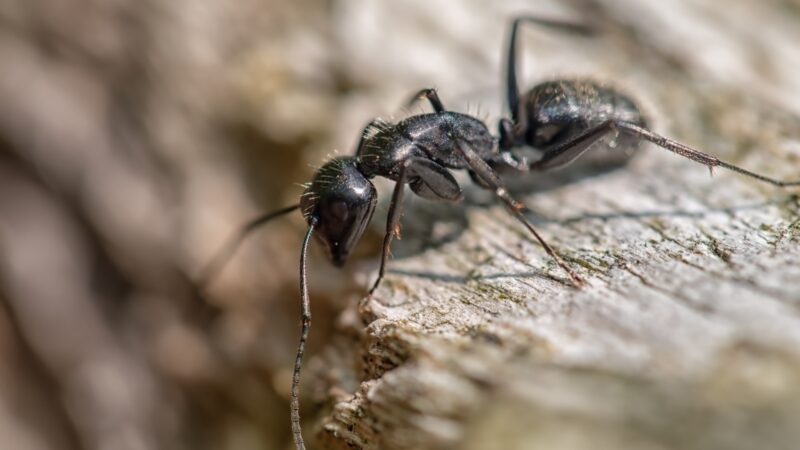
Having carpenter ants, especially the workers, can be frustrating and challenging to deal with. Since even a single winged female carpenter ant is a warning sign that a colony could be existing inside or around your house, don’t ignore it.
To help you, here are some tips on what to do if there are signs of carpenter ants:
1. Identify the Insect Correctly
Again, winged carpenter ants and winged termites look similar. But since ants don’t eat wood, the damage is limited to isolated areas of wood, and is clearly defined. The result is smooth, neat, and discolored tunnels. Termite damage results are more extensive and destructive inside rather than on the surface.
2. Locate the Ant Nest
Indoors, winged carpenter ants nest in moist areas such as around sinks and showers. Worker ants live in decaying wood, such as in door and window frames and between walls. Outdoors, these stubborn pests nest in rotten trees, wooden posts, and woodpiles. In most cases, they also have a satellite nest near their main nest.
3. Destroy the Nest
The success of destroying an ant nest depends on the age of the nest, the population of workers, and the method you will use. Spraying foraging workers with an insecticide is effective but is not a concrete solution since most of them are hiding deep in the nest and will just relocate. If the ant colony is huge, call an exterminator.
4. Prevent Them From Coming Back
Like other pest insects, carpenter ants are stubborn and are very likely to come back. The best way to prevent them is to make your home not suited for them. This includes removing all decaying wood, replacing the damaged window and door screens, fixing water leaks, eliminating their food sources, and regular inspections.
Why Do Flying Ants Suddenly Appear?
Flying ants suddenly appear because they had a chance to do so. Again, winged ants come out once they are ready to mate and establish a new colony.
These swarmers have no exact day of appearance and will depend on the weather. In fact, winged carpenter ants can have multiple nuptial flights throughout the year.
Is Carpenter Ant Damage Covered by Homeowners Insurance?
Carpenter ant damage is not usually covered by homeowners insurance unless it is caused by an accident. If a tree with carpenter ants fell on your roof and caused damage, and you are not aware that the tree is infested with ants, it is likely covered. But then, make sure you read the insurance company policies.
On the other hand, if you ignored a water leak that led to an ant infestation and the colony has caused damage to your property or belongings, the insurance company will not cover the expenses for the repair. This is why you should act immediately once there are leaks and check areas where ants could be hiding.
Do Carpenter Ants Go Away on Their Own?
Carpenter ants don’t go away on their own. Instead, they will continue expanding their colony for several years unless you destroy their nest or kill them.
A carpenter ant queen can live up to 25 years and will lay thousands of eggs during her lifetime. Worker ants also don’t leave even if their queen dies.
Nevertheless, you are unlikely to see carpenter ants during colder months, but it does not mean that they have already left their nest. Like most insects, these stubborn ants hibernate in the winter.
Aside from being inactive, they hide in the deepest parts of their galleries and will come out only once the weather is warm again.
Can You Get Rid of Carpenter Ants Without an Exterminator?
You can still get rid of carpenter ants without hiring an exterminator. But of course, it depends on the severity of the problem and the efficacy of the tools you will use. But if you discover the colony of these ants at an early stage and destroy their nest properly, you might no longer need the help of a professional.
Related: How to Get Rid of Carpenter Ants | Effective Strategies and Natural Solutions
List of Sources
Winged Carpenter Ants. Michigan State University.
Hahn, J., Kells, S. (2020). Carpenter ants. University of Minnesota Extension.
Carpenter Ant. (2019). National Park Service – U.S. Department of the Interior.
Carpenter Ants. (2021). University of Wisconsin-Milwaukee.
- How to Get Rid of Turtles | Proven Long-Term Solutions! - August 26, 2023
- How to Get Rid of Kingsnakes | Easy & Humane! - August 26, 2023
- How to Get Rid of Northern Water Snakes | Best Solutions and Preventative Measures! - August 19, 2023



